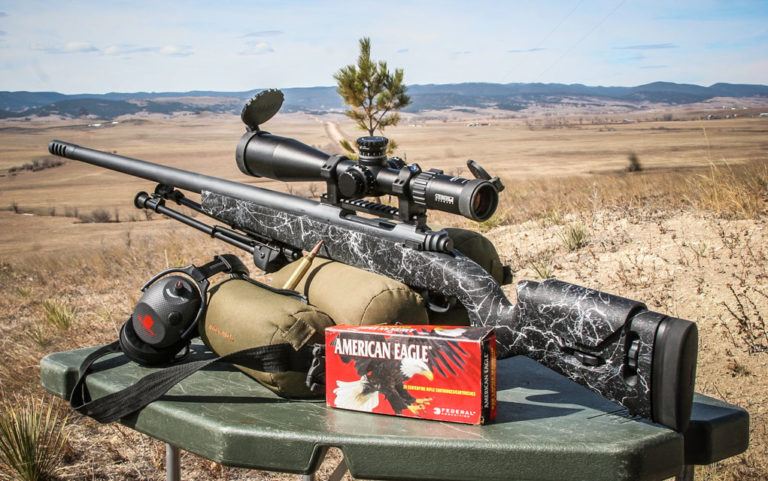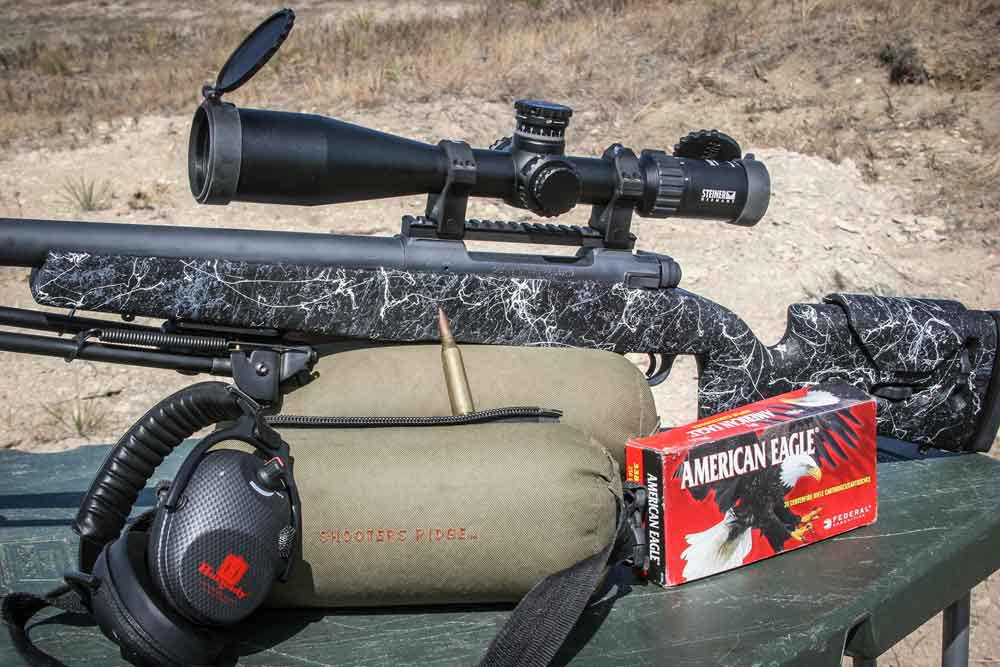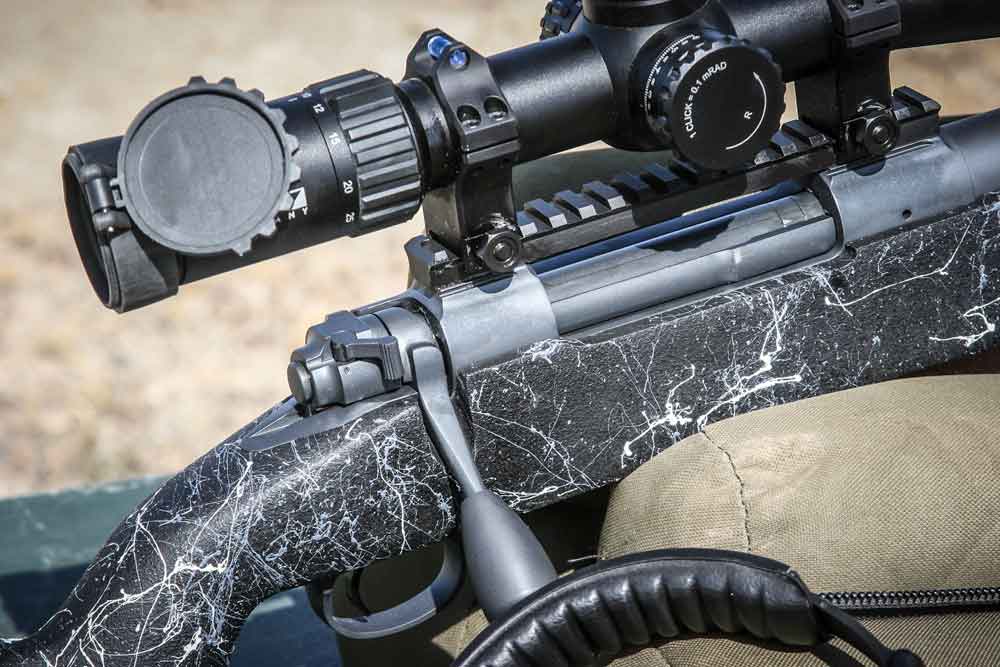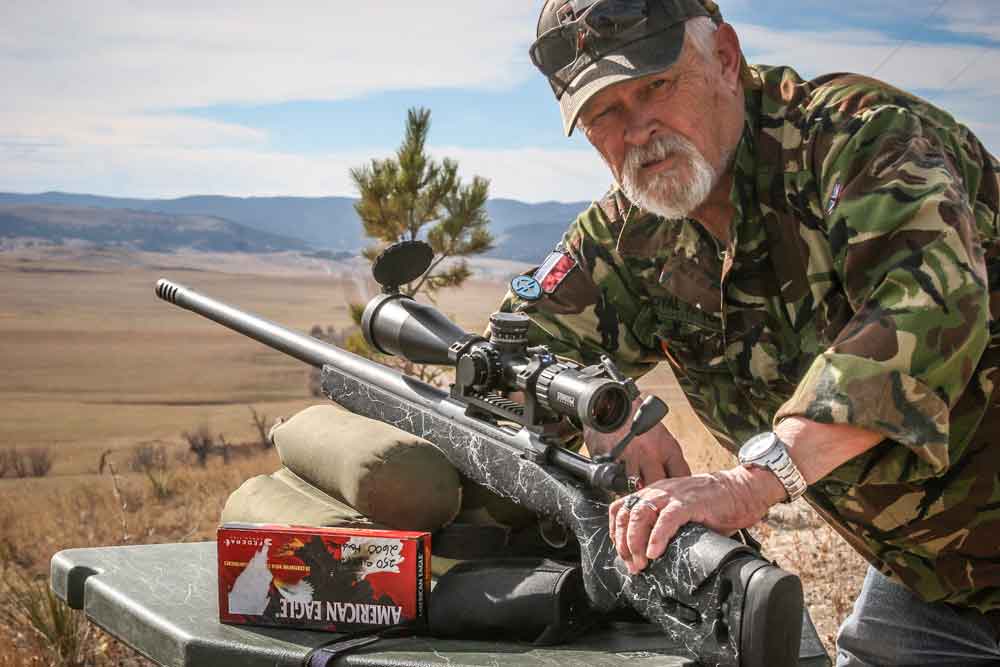
Montana Rifle Company's MTR, built on the manufacturer's Model 1999 Professional Hunter action and chambered in the potent .338 Lapua, certainly goes the distance.
What makes the Montana Rifle Company MTR an exceptional option for long-range shooting?
- The MTR is built on Montana Rifle Company's excellent Model 1999 Professional Hunter action, the manufacturer's largest, which is designed for big-bore cartridges like the .338 Lapua Magnum and .338 Norma Magnum in which the MTR comes chambered.
- The Model 1999 action combines some of the best attributes of the famed Mauser and Winchester Model 70 actions for supreme accuracy and reliability.
- The gun boasts a host of precision features such as a custom-built fully adjustable stock, a 26-inch hand-lapped button-rifled stainless steel barrel, and a quality Timney trigger.
- Montana Rifle Company states it to be a sub-1/2-MOA shooter out of the box, incredible accuracy for any rifle but especially useful as distances stretch.
 My first contact with the Montana Firearms group, the builders of Montana Rifles, took place this past fall near Brady, Texas, and the Champion ranch while hunting whitetail deer. At the time, I was testing a new Norma poly-tip bullet loaded in the .300 Win. Mag., and chambered in a sporter Model 1999. The rifle had been selected as the NRA gun of the year in 2016, and as it carried a set of controls exactly like those of my tried-and-true pre-1964 Winchester Model 70 Feather Weight in .30-06, I felt right at home with the near-custom-built rifle.
My first contact with the Montana Firearms group, the builders of Montana Rifles, took place this past fall near Brady, Texas, and the Champion ranch while hunting whitetail deer. At the time, I was testing a new Norma poly-tip bullet loaded in the .300 Win. Mag., and chambered in a sporter Model 1999. The rifle had been selected as the NRA gun of the year in 2016, and as it carried a set of controls exactly like those of my tried-and-true pre-1964 Winchester Model 70 Feather Weight in .30-06, I felt right at home with the near-custom-built rifle.
The details don’t take long to unveil here. Two days on tower stands, and two fine bucks dropped cleanly inside 200 yards with one well-placed shot on each. A previous field range day had yielded two shots touching at 100 yards, which ended my test phase and zeroing time in terms of hunting the Champion for trophy Texas whitetails. The bottom line is that I was very impressed by the sheer quality and performance of the Montana Rifle product, and when I found out they offered an advanced, heavy rifle design in a long-range .338 Lapua in the form of its MTR (Montana Tactical Rifle), the company had my full attention.
Following a short note to the folks at Montana Rifles, I was told the company had a sample of its MTR tactical .338 Lapua Model 1999 available for testing that could be sent my way. The Model 1999 Professional Hunter rifle was a heavy, full-scale sniper rifle and designed as a counter operations sniper system tailored to the kind of military or special operations work encountered in the Middle East. Given my background and having written three books on long-range shooting, as well as my numerous interviews with real-time, active, long-range snipers, I realized the possibilities associated with this rifle from the start.
The MTR, as we will call this death-at-a-distance shooting machine, is made up of a T-3 custom-built glass stock with full cheek adjustments, and length of pull (LOP) adjustments are built directly into its furniture. The exact LOP is 13 1/4 to 15 inches, and, as dressed in sniper gray, the rifle stock is quite handsome and retains a heavy-target contour look and basic design.
The metal work in the bottom metal is crafted like a fine piece of sculpture — smooth and snag-free edges, with a watchmaker’s fit. The barreled action retains a 26-inch button hand-lapped 1:10-in. twist barrel. The action on the MTR consists of the Model 1999 Montana PH model, which, for the most part, is almost a remake of an oversized Winchester Model 70, as previously noted. Making use of a Mauser-style ejector, this stainless steel receiver, which uses a controlled round feed, is built for accuracy at its core. Even just loading a round into the chamber, the shooter can “feel” the final, snug fit that requires a feather-light extra push into the hand-lapped breech face. After test shooting four additional .338 Lapua rifles back to back over the course of a year, I am now considering the MTR as a lead contender in terms of primary long-range shooting systems.
 Downrange
Downrange
Taking the rifle out for the customary “zero” run to 100 yards was eye opening. I fired a total of two rounds before getting a dead-on-the-target-center zero. Electing to use a military (Mil-Spec) German Steiner optic in Milrads proved to be a very good choice, in that its adjustments from the first focal plane as set at 10x were right on the money. The MTC muzzle break reacted to my handload, which consisted of a charge of RL 19 and a Sierra 250-grain MK bullet, with a sharp but almost gentle nudge.
The 18¾-pound rifle with optics rested in sandbags like an oversized sporter, and as such, illustrated its solid, flat base-stocked forend design similar to that used in a bench rest-style rifle, or, in my case, an ultra-long-range target/game hunting system. When firing, about the only reason I held on to the rifle much at all was to be sure and spot my exact bullet splash downrange for target correction in the event I missed my mark. Recoil is about the same as a medium-weight sporter chambered in .308 Winchester.
Shooting for groups, the handload previously indicated drilled a 0.671-inch group at 100 yards. Montana Rifles states that this rifle out of the box is a sub-1/2 MOA shooter with the PH #7 barrel and Timney trigger. I was shooting in light wind conditions in spring weather at about 3,000 feet above sea level, so I was fairly certain there’d be at least a small amount of deviation from the advertised ½ MOA figure. This rifle is a dead-on shooting system to be sure, and with the correct loads, it can push accurate bullets to distances as great as one mile or more. When I did start pushing bullets over some long-range real estate with the MTR, the rifle’s accuracy shined.
I must admit that I didn’t spend a lot of time with this review on 100-yard groups. When a pound of powder will yield about 50 rounds of ammunition, and even budget factory loads by Federal (American Eagle) cost upwards of $65.00 for a box of 20, things get costly pretty quick. Therefore, most of my attention was directed toward practical long-range steel targets after doing just a bit of work at the closer ranges. If a rifle like this can’t shoot long with solid accuracy, it is not worth the price of a custom-based system.
 On Steel
On Steel
I set up my bench rest table with some of my Sierra MTK 250-grain handloads (Federal brass and RL 19 powder) on a 100-foot bluff (Dead Horse Ridge) above the valley where my Action Target (AT) E-50 silhouette target, designed to take on rounds up to .50 BMG at range, was set up. With dry ground, which in the open range is nothing but dust, I would be able to pick up trace hits in the form of bullet splash with ease. As previously indicated, the Model 1999 in its heavy-tactical variant is an outstanding ultra-long-range rifle when you’re shooting alone, and that was the case on this day, as I was lacking a spotter.
With a loaded chamber, I checked the wind that I had previously measured at 10 to 15 mph, gusting. It was almost full value left to right, and by pushing two Milrads into it, then making an elevation adjustment of 7 Mils, I sent round number one through this handcrafted masterpiece. In a period of time that seemed like forever, I waited with my crosshairs dead center on the E-50 steel target. Almost three second went by when I was greeted by a bullet splash, which indicated I had shot just off the very right edge of the upper torso-size steel target. The elevation was good, but the stiff crosswind required a bit more correction.
Sighting for a second time, I now advanced to an additional 3/10 of a Mil but maintained the very same elevation of 7 mils. When the Timney trigger cut the sear and lifted off its 3 pounds of trigger weight, the second bullet was on its way to the 1,000-yard steel. Wait and hold was the order, and after a bit of time, the earth erupted all across the big steel plate angled toward the ground to prevent any bullet deflection. The bullet had hit a bit low, but well centered on the target. The dust and splash had been the big 250-grain Match King bullet coming apart all across the ground at the face of the target. With this system on dry ground, hits are easy to spot; although, I also have an outstanding Vortex spotting scope at hand for a detailed look at the freshly painted target surface when required.
Seven more rounds and three additional hits confirmed that the Montana MTR .338 Lapua was right at home to over one-half mile down range. Day number two, however, brought forth another set of obstacles that were somewhat of a challenge for the Montana super rifle. The winds at 100 feet above the valley floor were gusting to 25 mph when I arrived on site for the day’s test shooting. I was strongly thinking of packing the whole thing up for the day, as I noticed that, not only were winds crazy bad at the muzzle, but there was an obvious direction switch of 90 degrees at about 800 yards out. Two wind flags in the area put the wind at around 20 mph, so this was going to be tricky shooting at the least.
 I had handloaded a new load that I intended to run downrange that morning, so I decided to set up if for nothing less than to get a feel for a new IMR 7977 load of 94.6 grains behind the 250-grain Sierra MK bullet. This recommended load by my friend Kris Hodgdon, of the Hodgdon Powder Company, was right off the drawing board in terms of driving big bullets in the .338 Lapua. The new load picked up a full 200 fps increase downrange from the previous RL 19, and with these conditions cutting hang time (time of bullet flight from muzzle to the target), they would aid in the fight with the crazy crossing winds I was now about to face.
I had handloaded a new load that I intended to run downrange that morning, so I decided to set up if for nothing less than to get a feel for a new IMR 7977 load of 94.6 grains behind the 250-grain Sierra MK bullet. This recommended load by my friend Kris Hodgdon, of the Hodgdon Powder Company, was right off the drawing board in terms of driving big bullets in the .338 Lapua. The new load picked up a full 200 fps increase downrange from the previous RL 19, and with these conditions cutting hang time (time of bullet flight from muzzle to the target), they would aid in the fight with the crazy crossing winds I was now about to face.
I want to be clear in this case, the RL 19 was a downloaded round designed expressly for long-range whitetail deer hunting during the coming fall. It could have been moved up in grain weight, but as usual I was in the testing mode, and with the hotter loads in hand, the IMR 7977 propellant got the call.
Even though long range and wind don’t mix well, if more bullet and more powder can come to the rescue, so much the better. Now on hold and waiting for the gusting 25-mph winds to ease up, I was locked down on the bags with my safety off and eyes in the glass. At a reduced wind velocity of about 18 mph, I ran the same sight picture as the prior RL 19 load, then touched off the Montana MTR.
After a several-second time delay, the bullet erupted into a cloud of dust about 5 yards beyond the steel target, indicating a steep drift of a solid 2 yards to the right. My theory was that the bullet had traveled farther, and as such was being pushed by wind for a longer period of time, which translated to more bullet drifting. I could have been all wrong with that theory, but it felt right at the time, so I then pushed for another two mils into the variable, full-value wind, and also dropped a full mil off my elevation.
With the second round sent downrange, the dust exploded across the face of the big E-50 target plate, indicating a solid hit on steel. Even when shooting a rifle like the Montana MTR, there is an element of gut-level feeling that tends to come into play quite often when sending bullets through a wind storm at very long range. That stated, the sheer fact that the rifle was a very stable platform with solid accuracy to match, allowed me to make corrections and find success in getting my bullets on steel with a minimum amount of spent ammunition.
 Going Long
Going Long
Up to now I had been shooting the Montana MTR at close range. Well, not exactly close range, but not even close to what this rifle will deliver when checking into the next zip code. Just to make things interesting, I elected to turn to my Birchwood Casey “blue man” half-torso targets and a mock trench mortar set up as if being advanced on by an ISIS fire team. While I don’t play video games, I do like some element of realism when applying a rifle/cartridge like the .338 Lapua at a distant target. With three torso targets down behind a handmade cardboard mortar, I set up the whole deal at 1,400 yards, which was confirmed by my Leica 2000 rangefinder.
First off, the developing DOPE (Data on Previous Engagement) rolled out of my handheld smartphone ballistics app in seconds. While I didn’t expect the bullet impact figures to be exact, since everything is in constant change on the prairie minute by minute, I did figure that I would be able to hit close enough to pick up my bullet’s splash, then adjust my exact hold from that point on. With my “blue man” targets set in a pocket that consisted of prairie dog mounds and almost no vegetation at all, a dust cloud should have been somewhat easy to pick out.
The firing solution (DOPE) indicated that I should maintain a 16.5 mil holdover. With an angling wind of about 30 degrees right to left, I pulled for two mils, which took my cross hairs to the far right side of the cluster of cardboard bad guys. Now disengaging the Model 70-style safety and pulling the MTR’s butt stock into my shoulder solid, but not tight, I maintained my sight picture and sent round one downrange. Three plus seconds went by before the splash of the bullet turned up dirt directly over the far left cardboard member of the bad guy mortar team. I was about 3/10 of a mil high, and that was about normal for the 4-percent downward angle I was shooting from on the 100-foot elevated bluff, and I had failed to take that into consideration.
I dropped my elevation less than half the measurement of a single mil and maintained the same wind hold, and as the Timney trigger cracked once again, the mortar tube came apart, and the targeted Blue Man in the center of the group took the round almost dead center. When I make shots like that, it is like dusting a bull elk in my mind. Over the next 10 rounds, four bullets found their mark, and with the mortar tube eliminated and two targets hit, I felt that the MTR had done its job well, particularly given the wind conditions.
 Parting Shots
Parting Shots
During my interviews and real-time e-calls with on-location snipers over in the sand box, I have come to understand that many of them believe in the basic turn-bolt rifle with a very big cartridge in its chamber far and above some others. Harsh conditions shut down some systems, and the more complicated they are, the greater the risk of failure.
As I have illustrated here, the Montana Rifles MTR is, in my opinion, one of those systems that won’t quit when the conditions get rough. Quality design, construction, materials and cartridge choice make this a true custom rifle for next-zip-code-type applications. I fully realize that the .338 Lapua, or even the equally effective Norma .338 Magnum, are not every shooter’s choice. These big cartridges cost a whole lot of money to buy or even handload, and the paired rifles are not to be found on any bargain basement store shelves either.
What I do know is that rifles like this Montana Rifles creation are a specialized class of thunder stick. These types of rifles were born out of a need to hold off at a distance some very nasty people from doing their bad deeds. To that end, I feel the Montana MTR is extremely well suited. The MTR is available in .338 Lapua & .338 Norma Magnum.
Specifications:
Montana Rifle Company MTR (Montana Tactical Rifle)
Caliber: .338 Lapua Magnum, .338 Norma Magnum
Type: Bolt-action rifle
Barrel: 26 in., stainless steel, heavy target countour, hand lapped, button rifled, free floated
Barrel Finish: Sniper grey Cerakote
Overall Length: 48 in.
Stock: Custom T-11 stock, adjustable for cheek height and length of pull
Action: Montana Rifle Company (MRC) Model PH 1999
Trigger: Timney Trigger
MSRP: $3,625
Editor's Note: This article is an excerpt from the June 2017 issue of Gun Digest the Magazine.

Next Step: Get your FREE Printable Target Pack
Enhance your shooting precision with our 62 MOA Targets, perfect for rifles and handguns. Crafted in collaboration with Storm Tactical for accuracy and versatility.
Subscribe to the Gun Digest email newsletter and get your downloadable target pack sent straight to your inbox. Stay updated with the latest firearms info in the industry.

![Best Concealed Carry Guns In 2025 [Field Tested] Wilson Combat EDC X9S 1](https://gundigest.com/wp-content/uploads/Wilson-Combat-EDC-X9S-1-324x160.jpg)


![Best 9mm Carbine: Affordable PCCs [Tested] Ruger Carbine Shooting](https://gundigest.com/wp-content/uploads/Ruger-Carbine-Shooting-100x70.jpg)
![Best AR-15: Top Options Available Today [Field Tested] Harrington and Richardson PSA XM177E2 feature](https://gundigest.com/wp-content/uploads/Harrington-and-Richardson-PSA-XM177E2-feature-100x70.jpg)
